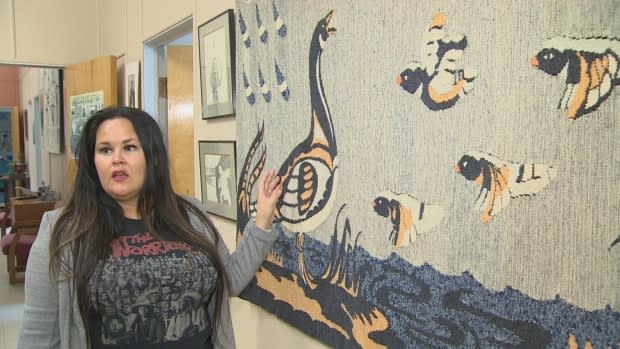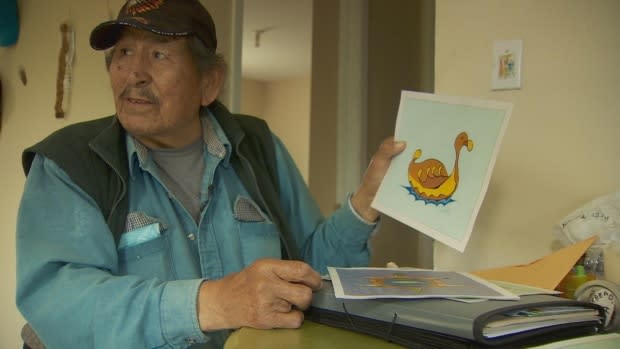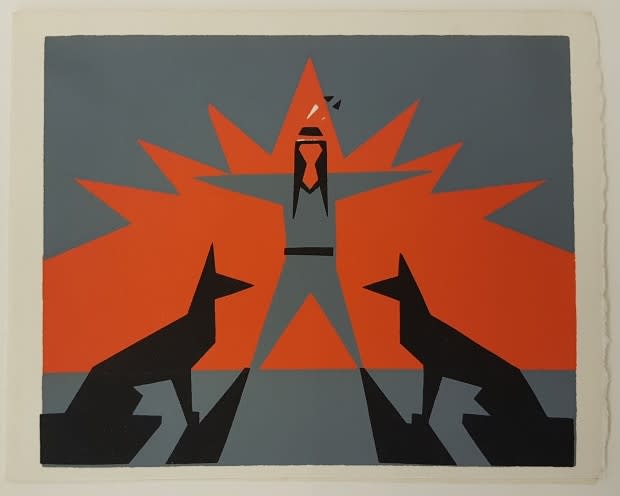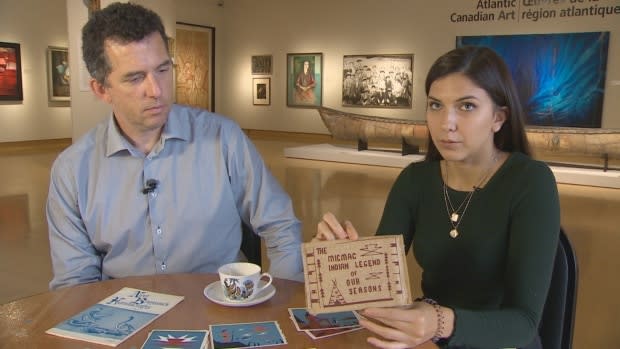Elsipogtog collective's art finds new life after half a century
Imagine going to work every day and getting the chance to admire the creations of local artists on the walls of your office.
Now imagine finding out that the art you admire every day — tapestries of familiar animals and lands — was made by a family member more than 50 years ago.
This is what happened to Starlit Simon, who works at the University of New Brunswick's Mi'kmaq-Wolastoqey Centre as a Mi'kmaq language teacher.
"As it turns out, the designs came from my great uncle Michael William Francis," Simon said.
"I did not know this. I've been working here, I think, about three to four years, went to school here, and the whole time these tapestries are here that my great uncle had made the designs for."

Her great uncle Michael Francis was part of the Micmac Indian Craftsmen, a group of artists from Big Cove First Nation, now Elsipogtog, who made prints and sold them all over as souvenirs for tourists.
"I didn't realize that they were his artwork because he didn't do tapestries," Simon added.
The tapestries that hang at UNB were made by renowned textile artist Ivan Crowell from designs by Francis and Stephen John Dedam.
After the designs were created, they were silk-screened onto cards, teacups and other souvenir-like items at a workshop in Elsipogtog.
"These were sold by the hundreds of thousands across Canada," said John Leroux, manager of collections and exhibitions at the Beaverbrook Art Gallery. "These were extremely popular."
It's an incredible story that again seems to have been forgotten by a lot of people, except the ones who are involved with it. - John Leroux, Beaverbrook Art Gallery
It was Leroux and Emma Hassencahl-Perley, a curator at the Fredericton gallery, who told Simon her great uncle's art was hanging on the walls of UNB.
The two curators were visiting the Mi'kmaq-Wolastoqey Centre as part of their research into the Micmac Indian Craftsmen for an exhibit coming to the gallery.
Francis died in 1995 at the age of 72.
Dedam, 80, who still lives in Elsipogtog, about 90 kilometres north of Moncton, said he didn't have an easy life growing up, and doing art was cathartic for him.

Painting was a way for him to create and "remain on a gentle stream," he said.
"When you sit down and dream about something else, you know, you turn around and you make your own world. And you find that very peaceful."
Thinking back on the importance of the Micmac Indian Craftsmen, who produced art from 1962 to 1966, Dedam said he hopes their work influences young Indigenous artists who may be struggling as he did.

"Art is very important because art doesn't get old, and it remains young as long as time," he said.
The Micmac Indian Craftsmen workshop in Elsipogtog burned down in the late-1960s.
Leroux and Hassencahl-Perley believe the fire and federal funding cuts were among the reasons for the demise of the collective, though the artists continued to create individually.
Putting workshop in historical perspective
Leroux and Hassencahl-Perley have been looking into the Micmac Indian Craftsmen for months in preparation for the Beaverbrook exhibit about the collective and the book that will accompany it.
"One of the things that Emma and I are really trying to focus on is that this appears to be really the initial stages of modern Indigenous art in Eastern Canada … and it's an incredible story that again seems to have been forgotten by a lot of people, except the ones who are involved with it.
"And when they talk about it, there seems to be a lot of warmth."

Leroux recently acquired some of the Elsipogtog collective's china tea sets and hasty cards, small cards for birthday wishes and other brief messages, from eBay. He remembers seeing one particular card design at home when he was a child.
The hasty cards featured art from Dedam and Francis on the front, accompanied by Mi'kmaq creation stories of Kluskap on the back.
"This is beyond just an Indigenous arts story," Leroux said. "This is some of the most sophisticated and creative graphics being done in New Brunswick in the 1960s.
"When you look at this, it's incredibly skilled. And to say that these were people that were dedicated to their craft and their culture, and could produce things that were being done as good as anyone. It was just in them, it was inherent and it's absolutely remarkable."

The Micmac Indian Craftsmen were also featured on the cover of the 1965 edition of an annual publication listing and describing artists in New Brunswick.
"All of the different craftspeople around New Brunswick, whether it's metalwork, woodwork, ceramics, they're all in here." Leroux said. "And on the very first page they actually have Micmac Indian Craftsmen."
In the book, the Elsipogtog artists are called the "most progressive group of craftsmen."
"They say, 'They're doing the most modern of crafts based upon designs from legends that are centuries old,'" Leroux said.
Hassencahl-Perley didn't even know about the artists until she started this project.
"Seeing it all come to light now, it's been really encouraging for me," she said. "I think just in terms of looking at design and, you know, artists that were here before me and have kind of paved this path for me, to exist in this realm."
Leroux expects the Micmac Indian Craftsman exhibit and book will be ready for the fall of 2020.


